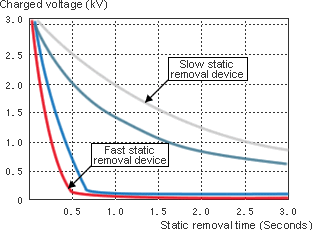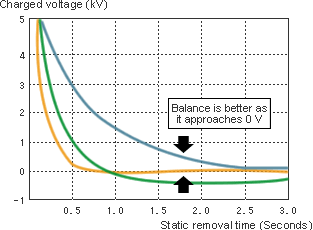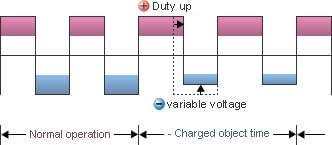|
|
The following 3 points cover the most important capabilities demanded from static removal devices

Static removal speed is a specification that expresses how much time it takes to lower a charged state to a fixed charged amount.
The capabilities of static removal speed are determined by how the ions required for static removal can be sent within a unit of time.
Due to this, a capacity to generate a large amount of ions is demanded.

Ion balance is an indicator that expresses how close static removal can come to 0 V and how close it can remain near 0 V. Normally expressed as ± x V.
The closer the ion balance is to 0 V, the greater the static removal capability.
Due to this, the consistent generation of an equal amount of ions is a condition for superior static removal.

Through the use of the Pulse AC System, the SJ-H series achieves outstanding ion balance.
(For information regarding the Pulse AC System, refer to Types of Corona Discharge Static Removal Devices). In addition to the Pulse AC system, in order to achieve the highest ion balance, the SJ-H Series is equipped with the DUAL I.C.C System, which has been further evolved from the traditionally well-established I.C.C System.
Whereas the conventional I.C.C. System was only applied to pulse width adjustment, Dual I.C.C. adjusts the voltage in addition to the pulse width, which has made it possible to perform automatic adjustments for perfect ion balance in wider areas.
Due to this, there is no need for adjustment during installation or maintenance, and it has become possible to always preserve perfect ion balance.
Static removal capability maintenance expresses how well certain static removal capabilities can be maintained.
In general, with traditional corona discharge static removal devices, the needle tips become dirty within a few weeks and static removal capability decreases. However, with the introduction of technology within the SJ series, the need for frequent maintenance can be drastically reduced.